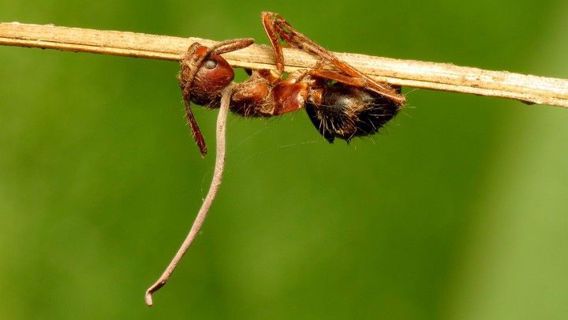
tropical forests, the ant species Camponotus leonardi lives in the high canopy and has an extensive network of aerial trails. Sometimes the canopy gaps are too difficult to cross, so the ants' trails descend to the forest floor where they are exposed to O. unilateralis spores. The spores attach to their exoskeletons and eventually break through using mechanical pressure and enzymes. Like other fungi pathogenic to insects in the genus Ophiocordyceps, the fungus targets a specific host species, Camponotus leonardi; despite this, the fungus may parasitize other closely related species of ants with lesser degrees of host manipulation and reproductive success.
Yeast stages of the fungus spread in the ant's body and presumably produce compounds that affect the ant's hemocoel, using the evolutionary trait of an extended phenotype to manipulate the behavioral patterns exhibited by the ant. An infected ant exhibits irregularly timed full-body convulsions that dislodge it from its canopy nest to the forest floor.
The changes in the behavior of the infected ants are very specific, giving rise to the popular term "zombie ants." Behaviors are tuned for the benefit of the fungus in terms of its growth and its transmission, thereby increasing its fitness. The ant climbs up the stem of a plant and uses its mandibles with abnormal force to secure itself to a leaf vein, leaving dumbbell-shaped marks on it. The ants generally clamp to a leaf's vein at a height of 26 cm above the forest floor, on the northern side of the plant, in an environment with 94–95% humidity and temperatures between 20 and 30 °C (68 and 86 °F). Infections may lead to 20 to 30 dead ants per square meter. When the dead ants are moved to other places and positions, further vegetative growth and sporulation either fails to occur or results in undersized and abnormal reproductive structures. In temperate forests, the typical behavior of zombie ants is to attach themselves to the lower side of twigs, not leaves.
A search of plant-fossil databases revealed similar marks on a fossil leaf from the Messel Pit, which is 48 million years old.[14][15] Once the mandibles of the ant are secured to the leaf vein, atrophy quickly sets in, destroying the sarcomere connections in the muscle fibers and reducing the mitochondria and sarcoplasmic reticular. The ant is no longer able to control the muscles of the mandible and remains fixed in place, hanging upside-down on the leaf. This lockjaw trait is popularly known as the death grip and is essential in the fungus's lifecycle. A study led in Thailand revealed that there is a synchronization of this manipulated biting behavior at solar noon.
The fungus then kills the ant and continues to grow as its hyphae invade more soft tissues and structurally fortify the ant's exoskeleton. More mycelia then sprout out of the ant, securely anchoring it to the plant substrate while secreting antimicrobials to ward off competition. When the fungus is ready to reproduce, its fruiting bodies grow from the ant's head and rupture, releasing the spores. This process takes 4–10 days. Dead ants are found in areas termed "graveyards" which contain high densities of dead ants previously infected by the same fungus.
The term "zombie ants" has been used in popular media as well as scientific articles, but has also been described as "catchy, yet misleading.
The principal hosts of O. unilateralis evolved adaptive behaviors able to limit the contact rate between uninfected susceptible hosts and infected hosts, thereby reducing the risk of transmission.
O.unilateralis' principal hosts evolved efficient behavioral forms of social immunity. In fact, the ants clean the exoskeletons of one another in order to decrease the presence of spores which are attached to their cuticle. Also, ants can sense that a member of the colony is infected, resulting in healthy ants carrying the O. unilateralis-infected individual far away from the colony to avoid fungal spore exposure. Plus, there are reports testifying that most worker ants remain inside the nest boundaries; consequently, only foragers are at risk of infection.
Moreover, one of the fungus' principal hosts, Camponotus leonardi, provided evidence for the avoidance of the forest floor by the host ants as a defence method. In areas where O. unilateralis is present, C. leonardi builds its nests high in the canopy, and has a broad network of aerial trails. These trails occasionally move down to the ground level, where infection and graveyards occur, due to canopy gaps too difficult for the ants to cross. When the trails descend to the forest floor, their length is only of three to five meters before going back up into the canopy. This demonstrates the avoidance of the zones of infection by the ants. Additionally, more evidence participates in the favour of this defence method being adaptive as it is not observed in undisturbed forests where the zombie-ant fungus is not present.
Follow TechoGenius to stay updated on their latest posts!
0 comments
Be the first to comment!
This post is waiting for your feedback.
Share your thoughts and join the conversation.
